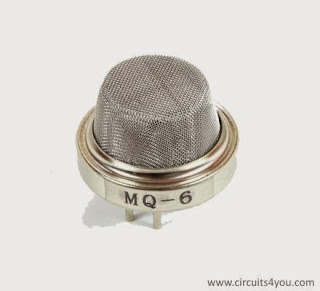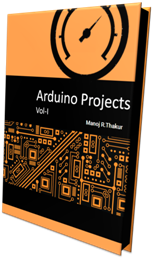MQ-6 gas sensor modules are used in gas leakage detecting equipments in family and industry, are suitable for detecting of LPG, iso-butane, propane, LNG, avoid the noise of alcohol and cooking fumes and cigarette smoke.
Connection Diagram:
VCC - 5V
GND - GND
S - Analog pin0
Code:
int sensorValue; int GasSensorPin = 0; //Gas Sensor Connection void setup() { Serial.begin(9600); // sets the serial port to 9600 } void loop() { sensorValue = analogRead(GasSensorPin); // read analog input pin 0 Serial.println(sensorValue, DEC); // prints the value read delay(100); // wait 100ms for next reading }
Advance Detailed Code:
/*==============Demo for MQ-6 Gas Sensor Module ======= www.circuits4you.com ======================================================*/ /*========Hardware Related Macros=====================*/ #define MQ_PIN (0) //define which analog input channel you are going to use #define RL_VALUE (20) //define the load resistance on the board, in kilo ohms #define RO_CLEAN_AIR_FACTOR (10) //RO_CLEAR_AIR_FACTOR=(Sensor resistance in clean air)/RO, //which is derived from the chart in datasheet /*============Software Related Macros ===============*/ #define CALIBARAION_SAMPLE_TIMES (50) //define how many samples you are going to take in the calibration phase #define CALIBRATION_SAMPLE_INTERVAL (500) //define the time interal(in milisecond) between each samples in the //cablibration phase #define READ_SAMPLE_INTERVAL (50) //define how many samples you are going to take in normal operation #define READ_SAMPLE_TIMES (5) //define the time interal(in milisecond) between each samples in //normal operation /*=============Application Related Macros============*/ #define GAS_LPG (0) #define GAS_CH4 (1) /*===============Globals=============================*/ float LPGCurve[3] = {3, 0, -0.4}; //two points are taken from the curve. //with these two points, a line is formed which is "approximately equivalent" //to the original curve. //data format:{ x, y, slope}; point1: (lg1000, lg1), point2: (lg10000, lg0.4) float CH4Curve[3] = {3.3, 0, -0.38}; //two points are taken from the curve. //with these two points, a line is formed which is "approximately equivalent" //to the original curve. //data format:{ x, y, slope}; point1: (lg2000, lg1), point2: (lg5000, lg0.7) float Ro = 10; //Ro is initialized to 10 kilo ohms void setup() { Serial.begin(9600); //UART setup, baudrate = 9600bps Serial.print("Calibrating...\n"); Ro = MQCalibration(MQ_PIN); //Calibrating the sensor. Please make sure the sensor is in clean air //when you perform the calibration Serial.print("Calibration is done...\n"); Serial.print("Ro="); Serial.print(Ro); Serial.print("kohm"); Serial.print("\n"); } void loop() { Serial.print("LPG:"); Serial.print(MQGetGasPercentage(MQRead(MQ_PIN)/Ro,GAS_LPG) ); Serial.print( "ppm" ); Serial.print(" "); Serial.print("CH4::"); Serial.print(MQGetGasPercentage(MQRead(MQ_PIN)/Ro,GAS_CH4) ); Serial.print( "ppm" ); Serial.print("\n"); delay(200); } /*=============== MQResistanceCalculation ================== Input: raw_adc - raw value read from adc, which represents the voltage Output: the calculated sensor resistance Remarks: The sensor and the load resistor forms a voltage divider. Given the voltage across the load resistor and its resistance, the resistance of the sensor could be derived. ============================================================*/ float MQResistanceCalculation(int raw_adc) { return ( ((float)RL_VALUE*(1023-raw_adc)/raw_adc)); } /*===================== MQCalibration ====================== Input: mq_pin - analog channel Output: Ro of the sensor Remarks: This function assumes that the sensor is in clean air. It use MQResistanceCalculation to calculates the sensor resistance in clean air and then divides it with RO_CLEAN_AIR_FACTOR. RO_CLEAN_AIR_FACTOR is about 10, which differs slightly between different sensors. ============================================================*/ float MQCalibration(int mq_pin) { int i; float val=0; for (i=0;i<CALIBARAION_SAMPLE_TIMES;i++) { //take multiple samples val += MQResistanceCalculation(analogRead(mq_pin)); delay(CALIBRATION_SAMPLE_INTERVAL); } val = val/CALIBARAION_SAMPLE_TIMES; //calculate the average value val = val/RO_CLEAN_AIR_FACTOR; //divided by RO_CLEAN_AIR_FACTOR yields the Ro //according to the chart in the datasheet return val; } /*==================== MQRead =============================== Input: mq_pin - analog channel Output: Rs of the sensor Remarks: This function use MQResistanceCalculation to caculate the sensor resistenc (Rs). The Rs changes as the sensor is in the different consentration of the target gas. The sample times and the time interval between samples could be configured by changing the definition of the macros. ============================================================*/ float MQRead(int mq_pin) { int i; float rs=0; for (i=0;i<READ_SAMPLE_TIMES;i++) { rs += MQResistanceCalculation(analogRead(mq_pin)); delay(READ_SAMPLE_INTERVAL); } rs = rs/READ_SAMPLE_TIMES; return rs; } /*======================= MQGetGasPercentage ================== Input: rs_ro_ratio - Rs divided by Ro gas_id - target gas type Output: ppm of the target gas Remarks: This function passes different curves to the MQGetPercentage function which calculates the ppm (parts per million) of the target gas. ===============================================================*/ int MQGetGasPercentage(float rs_ro_ratio, int gas_id) { if ( gas_id == GAS_LPG ) { return MQGetPercentage(rs_ro_ratio,LPGCurve); } else if ( gas_id == GAS_CH4 ) { return MQGetPercentage(rs_ro_ratio,CH4Curve); } return 0; } /*======================== MQGetPercentage =================== Input: rs_ro_ratio - Rs divided by Ro pcurve - pointer to the curve of the target gas Output: ppm of the target gas Remarks: By using the slope and a point of the line. The x(logarithmic value of ppm) of the line could be derived if y(rs_ro_ratio) is provided. As it is a logarithmic coordinate, power of 10 is used to convert the result to non-logarithmic value. ===============================================================*/ int MQGetPercentage(float rs_ro_ratio, float *pcurve) { return (pow(10, (((log(rs_ro_ratio)-pcurve[1])/pcurve[2]) + pcurve[0]))); }
Output:
Check output on Serial Monitor








how can modify this program for displaying output on lcd....
ReplyDeleteinstead of this "Serial.println(sensorValue, DEC); " use LCD.print
DeleteCan some one explean me the CH4Curve[3] = {3.3, 0, -0.38}, looking to the datasheet the initial value is at 2.5....
ReplyDelete